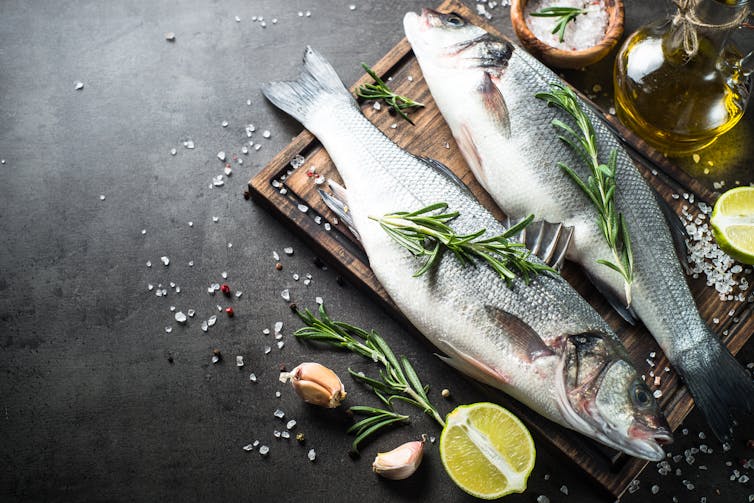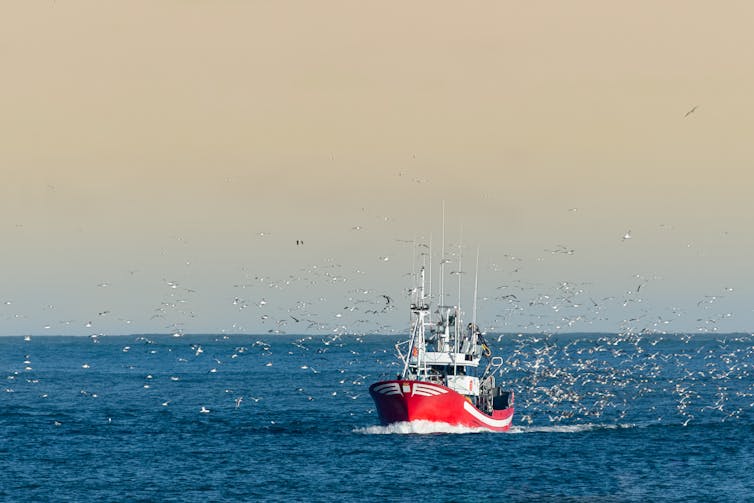The following article by Dave Little and Richard Newton was published in The Conversation on 22nd September 2021.
How fish can still be part of a more sustainable food future

If you want to reduce your personal impact on the environment, cutting back on eating animal products is one of the simplest things you can do. But becoming vegan and eating only plants is unlikely to be an appropriate solution for everyone in the world.
Fish and other seafood is often overlooked by the environmentally conscious, but new research known as the Blue Food Assessment show they can be part of meeting the twin challenges of climate change and food security. This year’s UN Summit of Food Systems is embracing “blue foods”, fish, shellfish and other food raised in water, to complement that of “green foods”, those that come from the land, plants and animals.
The five research papers from more than a hundred scientists led by Stockholm and Stanford universities highlight how aquatic foods could be used in the coming decades to address malnutrition, lower the environmental footprint of the food system, and provide livelihoods – echoing much other work that has been done in this area.
The growing, processing and distributing of food contributes a massive proportion of the greenhouse gas emissions that are the underlying cause of climate change, while huge numbers of people still suffer from malnutrition, obesity and sometimes both. Some seafood has the potential to provide people with high value nutrition while producing relatively low emissions.
But research suggests there are significant variations in the climate impacts and micronutrient content of both farmed and wild fish, that is affected by species, size and system. Scientists are only just beginning to understand these and the potential trade-offs.
The problem is that all seafood is often lumped together, making it hard to accurately compare it to other food sources. While we are able to draw some conclusions about what seafood is best for us to eat, the picture is usually complicated, and we don’t always have all the data we need.
The most commonly farmed species globally, including carp, trout, salmon, catfish and tilapia, have environmental impacts comparable to those of chicken, the most efficient and widely consumed meat –and so much lower than that of beef or lamb. But how fish are raised can make a big difference. For example, filter-feeding carps in freshwater systems have lower carbon emissions per portion but carnivorous marine fish such as seabass have much higher emissions.
More than half of seafood consumed globally is still fished, rather than farmed, and there is a significant range in the carbon emissions associated with different fisheries, largely reflecting the different methods used and stock abundance. Farmed fish can be made more environmentally friendly if less feed is used to produce the same amount of consumed product.
Meanwhile, some unfed farmed species can also have a positive impact on the environment. For example, mussels, clams and oysters filter natural feed from the water, removing excess nutrients.
There is also a stark difference in the diversity of aquatic farming compared with that on land. Whereas only a handful of farmed animals (chicken, pigs, sheep and cattle) provide the bulk of meat eaten by humans, more than 400 aquatic animal species are now farmed. A greater variety of food and sources for it helps improve food security as well as spreading risks for farmers. And, critically, this biodiversity can support more diverse and nutritious diets.
Source of nutrition
As one of the new studies highlights, many fish and seafood species are rich in important nutrients, which can give it a distinct advantage over meat with similar or higher environmental impact. Compared to chicken, trout has approximately 19 times more omega-3 fatty acids. Oysters and mussels have 76 times more vitamin B-12 and five times more iron. And carp have nine times more calcium.
The nutritional benefits of aquatic food are especially important for women, who benefit more than men from increased consumption in nearly three times the number of countries studied, the research found.
As such, seafood can be critical to reducing malnutrition among at-risk groups globally such as children and adolescent women. For the better off, substituting fish for meat can lower the risk of poor health associated with cardiovascular and other diseases.

But again, the picture is complex. For example, small fish eaten whole are generally more nutritious than eating only fillets. Fish are often promoted as healthy because of the high levels of essential omega-3 fatty acids that some species contain. But the greatest dietary value will come from eating a diverse range of seafood to obtain a wider range of micronutrients.
Global climate challenges and fish
However, many challenges remain for seafood to fulfil its potential as a low-impact, highly nutritional food source for a large proportion of the world’s population. To have climate-friendly fishing, we must encourage the most sustainable development of the industry and protect the livelihoods of small-scale fishers and farmers. Incentivised production and trading of fish could drive down prices, ensuring poorer people can still afford seafood as other people’s incomes rise and demand increases.
But this latest research brings convincing evidence to the table of how good choices of fish and seafood can be both good for people and the planet and will be important in making sure they become a larger part of the global diet.![]()
Dave Little, Professor of Aquatic Resources Development, University of Stirling and Richard Newton, Research fellow, University of Stirling
This article is republished from The Conversation under a Creative Commons license. Read the original article.
